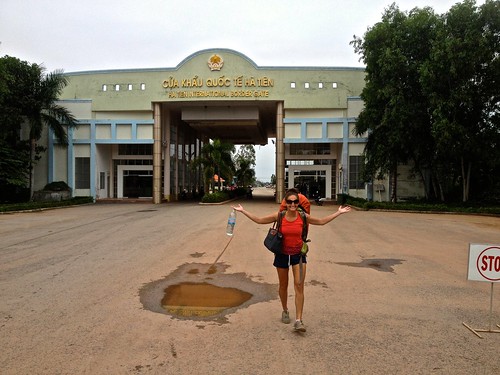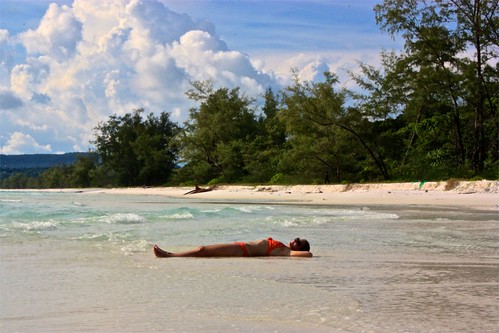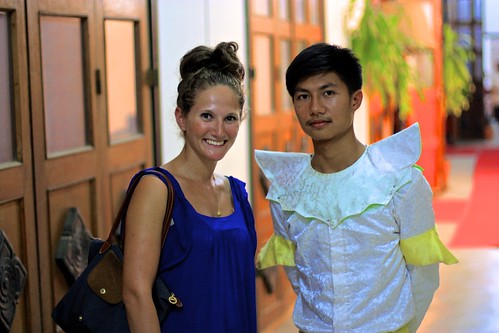Almost every long-term travel blog has a packing list, which is why I wasn't going to write one for our blog.
But after several emails and questions from readers who say they're "just like us," I figured I might as well put something together for you guys. (Full disclosure: some of these links are affiliate links, which means if you click them and then buy something, Rob and I get a tiny percentage of your purchase.)
But first, not every traveler is alike, so let's be clear on who this list is for.

This packing list is awesome for travelers who are:
- Traveling for a while, but moving around a lot, which basically means living out of a backpack. (If you stay in one place for a month or so, a suitcase or duffel bag may make more sense than a true pack.)
- Value-driven: in other words, not staying in bunk beds, but no staying in 5 star hotels either.
- Adventurers: if you're just planning to lie on a beach, these things may not all make sense for you.
- Willing to wash clothes regularly.
- Excited to take risks and experience a new way of life.
- More flashpacking than backpacking.
- Don't want to look like total bums on the road.

Sound like you? Keep on reading then!
My Personal Opinion on Travel “Essentials”
- Silk sleep sheet: Absolutely necessary if you’re planning on traveling on a budget. I always slept a lot better at night knowing that my sheet was perfectly clean. Our Sea to Summit one was comfortable and still feels soft after a year of use.
- Packing cubes: After reading a lot of glowing reviews, we bought them, but returned them before leaving on our trip. I just don’t get the sense of using them since they require you to unpack your ENTIRE bag just to get to your shirts. As long as you pack your pack well, you should always be able to reach the one article of clothing you need without needing a packing cube.
- Compression sack: We used a Sea to Summit compression pack for our coats and cold weather items. It worked really well because we hardly ever needed these things, which meant that we didn’t unpack the sack too often—unlike a packing cube which you would open daily. We kept it at the bottom of Rob’s pack, where it lived happily ever after until we got to high altitudes.
- Waterproof sacks: We bought a pack of three cheap “water resistant” bags. They came in handy for our first aid kit (the red), charging station/electronics (the blue), and extra random clothes (the yellow). I also used a lingerie bag for my small items. In case you don’t get it, bags are good. They keep your backpack organized. But you don’t need to pay $30 per bag. That’s not good. It’s stupid.
- SIM cards: The only time we bought a local SIM was when we lived in New Zealand for 7 months. Otherwise, hotel WiFi always sufficed.
- Neck pillows: Abso-freaking-lutely. Pay the extra money for a nice memory foam one, like our SilverRest ones. It was the only pillow we had some nights.
- Duct tape: Yes. Wrap some around a pen and it does double duty.
- Headlamps: Yes. Plus batteries. The ones in developing countries are often expired when you buy them, so they don’t last very long.
- A safety whistle and rope: Why not? It may be overkill, but I never regretted having it.
- An alarmed doorstop: This is overkill, or maybe I just feel that way because I traveled with a man. Anyway, some women travelers swear by it. If you’re traveling by yourself and staying in budget places, it may be worth getting.
- A padlock: I could pick many of the “locks” at our hotels with my eyes closed, so having my own padlock made me feel just a tad bit better about leaving our things in the room. That said, if you have valuables, use the hotel safe.
- A clothesline: Undecided. Rob accidentally left our Sea to Summit one hanging (haha) at a lodge in Thailand, so we were stuck using the rope for the rest of the time. The rope works, but it needs something to keep it up, while the clothesline was designed to hang anywhere. Anyway, not a necessity, but I did miss it after it was gone.
- A Diva menstrual cup: Yes, yes, yes. If you’re a woman, you absolutely have to have one of these. Not only does it save money and the environment, but it’s the best thing to travel with when you have your period.
- A money belt: It’s a dorky necessity. The one I linked to still looks like new after 9 months of constant use.
- Pack towels: I’ve used our Sea to Summit towels for towels, blankets, even a skirt. They dry quickly and don’t smell. Plus, sometimes “clean” towels in Asia don’t seem that appealing.
- A Steripen: Shoot me if you will, but we did buy bottled water for about seven months in Asia. Once we knew we’d be doing Everest, we had my mom bring Aquamira water purification drops. They were awesome and worked really well. We only had to wait for 15 minutes to drink the water and it never tasted funny. Do I regret buying bottles all those months? A bit for the environment, but I have to say, cold water never tasted so good.
- A non-branded camera strap: Seeing as we’re basically a walking Apple store, we didn’t want to bring any more attention than necessary to our tech heavy packs. A simple black camera strap instead of the branded Canon one made us a little less theft-worthy.
- One of those crazy PacSafe netted lock things for your backpack: We considered buying one of these babies, but I decided it was overkill. Instead we invested in simple zip cable ties. Unfortunately, we only used them on the trains in India, which means a few things including my prescription glasses and some luggage locks (ironic) went missing in transport. Crazy, right? Anyway, the zip ties obviously won’t stop a determined thief, but they do deter crimes of opportunity. We ziptied all the zippers closed, tied the bags together, and then used the padlock to attach them to the seat. Another interesting option we saw travelers use is a backpack that goes inside a big black bag that then padlocks shut. It basically makes your big impenetrable. (I tried to find a link, but couldn’t. This company used to make them.
- A collapsible daypack: We each have a daypack, which is highly recommended. Rob typically uses the REI Flash 18 daypack (with a built in safety whistle). The straps are a bit beat up now, so we’re planning on getting it replaced when we get home, but the pack is comfortable, fits enough for a three day trek, and is really affordable. (It looks like REI has debuted a new design for it, so we’ll see how the new one is.) We also have a Sea to Summit Ultra-Sil Dry Day Pack for our electronics. This one is less affordable and isn’t as comfortable because the straps are narrow and cut into your shoulders. We put a MacBook Air in it during our first trek in Burma and it started ripping right away. The company was really nice about it and sent us a new one for free, but they did say it’s not meant to sustain weight from something non-malleable like a computer. For the rest of the trip, we used the ripped bag for the computer, which we placed in the REI daypack. Then I used the new Sea to Summit bag for softer items like clothes.
- Amazing backpacks: Your pack is your home. It can be your best friend or your worst enemy. The worst thing you can do if you’re planning on backpacking is be stingy when you buy your pack. Rob and I both swear by our Gregory packs. They’re still in amazing shape, fit perfectly, and allowed us to distribute weight as necessary throughout our many adventures. Rob wouldn’t change anything about his Baltoro 75 Technical Pack. I have the Jade 50 in XS, which is for petite people like me. I love it except for one thing—it doesn’t open from the front like Rob’s, which means sometimes it’s harder to find things. Other than that, it’s perfect. (One thing I would mention about backpacks is the importance of trying it on before you buy and having a knowledge salesperson adjust the back for you. That's how I found the perfect pack for my petite frame.)
- Pack cover: Umm, yes. What’s the point of a good backpack if it just gets soaked? Invest in a good cover and make your life that much better. My Sea to Summit one looks beat up, but it kept my things nice and dry.

What About Clothes?
Here's the edited version of my pack for most of Asia:
- Two sundresses - one casual, one fancier
- Four pairs of shorts - running, cotton, fancier cotton, fun bright color denim. (I could have probably been okay with 3 pairs.)
- Long sleeve bug repellent shirt
- Short sleeve bug repellent t-shirt
- Five tanks - three casual, two fancier, four of which were wrinkle-resistant from Lucy and one from H&M that got lost in laundry early in the trip
- Two t-shirts - I could have probably gone down on the tanks and up one on the tees, especially since one got lost in laundry fairly early. (T-shirts are key if you're going into temples since your shoulders need to be covered.)
- Denim button down shirt from H&M - last minute addition that was perfect for putting on over a dress or with shorts
- Lululemon leggings - great for travel days, but dead from all the wear and tear
- A bright cardigan from J. Crew - bright colors make you look more put together, so just make sure it goes with several tops and bottoms
- Three bikinis (I know!) - take at least two , one for hanging out on the beach and one for doing more active adventures
- A beach cover up/cotton dress from H&M
- Three head coverings - a sun hat, a trekking hat, and a bug repellent bandana
- Zip off hiking pants by North Face
- Long sleeve performance running shirt from Brooks - good for trekking, though any performance shirt will do
- North Face trekking shoes
- North Face water shoes/sneakers - really good to walk around in all day
- Rubber flip flops
- Fancier leather sandals
- Minnetonka mocassins - the most comfortable flats ever and can be dressed up or down
- Four pairs of ExOfficio underwear
- Three pairs of socks - two regular, one trekking
- Five bras - three regular to go with tops, two sport bras
- Patagonia fleece jacket, similar to this
- Marmot ski jacket/windbreaker
- PJs
- Cotton scarf that can double as a skirt when needed
- Two pairs of loose pants, bought in India
- Sarong bought in Bali

Sound like a lot or a little? I could have absolutely packed less, but I wanted to look more like a human than a backpacker, so I added in some elements that are certainly not essential, like five pairs of shoes and three bathing suits. Even with all this, my pack weighed a max of 12kg.
Golden rule: Pack your pack and walk around your town/city for an hour with it on. If you're dying, your pack is too heavy. If you're okay, then it's perfect. Don't add more stuff!
The other thing to think about is how wrinkle-resistant and quick drying your things are. I tried to get performance-like clothes that didn't look like workout clothes because they don't wrinkle and dry fast. In humid climates, quick drying items are a godsend.
What Did You Pack for the Road?
Let us know if there's anything you loved or hated about how you packed! Also, if you're interested in my thoughts on what to leave behind and what didn't last, read my What to Pack post here.
Comments